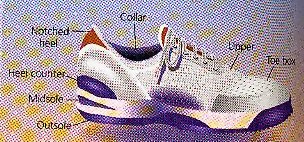Good Athletic Footwear |
|
Choosing Exercise Footwear |
|
Footwear is perhaps the most important item of equipment for almost any activity. Shoes protect and support your feet and improve your traction. When you jump or run, you place as much as six times more force on your feet than when you stand still. Shoes can help cushion against the stress that this additional force places on your lower legs and thus prevent injuries. Some athletic shoes are also designed to help prevent ankle rollover, another common source of injury. |
|
Shoe Terminology
|
|
Understanding the structural features of athletic shoes can help you make sound choices. Outsole: The bottom of the shoe that touches the ground and provides traction. The shape and composition of an outsole depend on the activity for which the shoe is designed. Midsole: The layer of shock-absorbing material located between the insole and the outsole; typically composed of polyurethane, ethyl vinyl acetate (EVA), or another cushioning material. For improved durability, some shoe midsoles include encapsulated air or gel. Insole: The insert or sock lining that the foot rests inside the shoe, usually contoured to fit the foot and containing additional cushioning and arch and heel support. Collar: The opening of the shoe where the foot goes in. Upper: The top part of the shoe, usually made of nylon, canvas, or leather. Toe box: The front part of the upper, which surrounds the toes. Heel counter: The stiff cup in the back of the inside of the shoe that provides support and stability. Notched heel:Some shoes have raised heel padding to support the Achilles tendon. Stabilizers:Bars or strips of rubber, polyurethane, or nylon near the heel or forefoot area of some shoes; they provide additional stability. Wedge: The thick portion of the midsole that makes the heel higher than the ball of the foot in some shoes. |
|
General Guidelines |
|
When choosing athletic shoes, first consider the activity you've chosen for your exercise program. Shoes appropriate for different activities have very different characteristics. For example, running shoes typically have highly cushioned midsoles, rubber outsoles with elevated heels, and a great deal of flexibility in the forefoot. The heels of walking shoes tend to be lower, lass padded, and more beveled than those designed for running. For aerobic dance, shoes must be flexible in the forefoot and have straight, nonflared heels to allow for safe and easy lateral movements. Court shoes also provide substantial support for lateral movements; they typically have outsoles made from white rubber that will not damage court surfaces. Also consider the location and intensity of your workouts. If you plan to walk or run on trails, you should chose shoes with water-resistant, highly durable uppers and more outsole traction. If you work out intensely or have a relatively high body weight, you'll need thick, firm insoles to avoid bottoming-out the cushioning system of your shoes. Foot type is another important consideration. If your feet tend to roll in excessively (overpronate), you may need shoes with additional stability features on the inner side of the shoe to counteract this movement. If your feet tend to roll outward excessively (oversupinate), you may need highly flexible and cushioned shoes that promote foot motion. For aerobic dancers with feet that tend to pronate or supinate, mid-cut to high-cut shoes may be more appropriate than low-cut aerobic shoes or cross-trainers (shoes designed to be worn for several different activities). Compared with men, women have narrower feet overall and narrower heels relative to the forefoot. Most women will get a better fit if they choose shoes that are specifically designed for women's feet rather than those that are down-sized versions of men's shoes. For successful shoe shopping, keep these strategies in mind:
|
